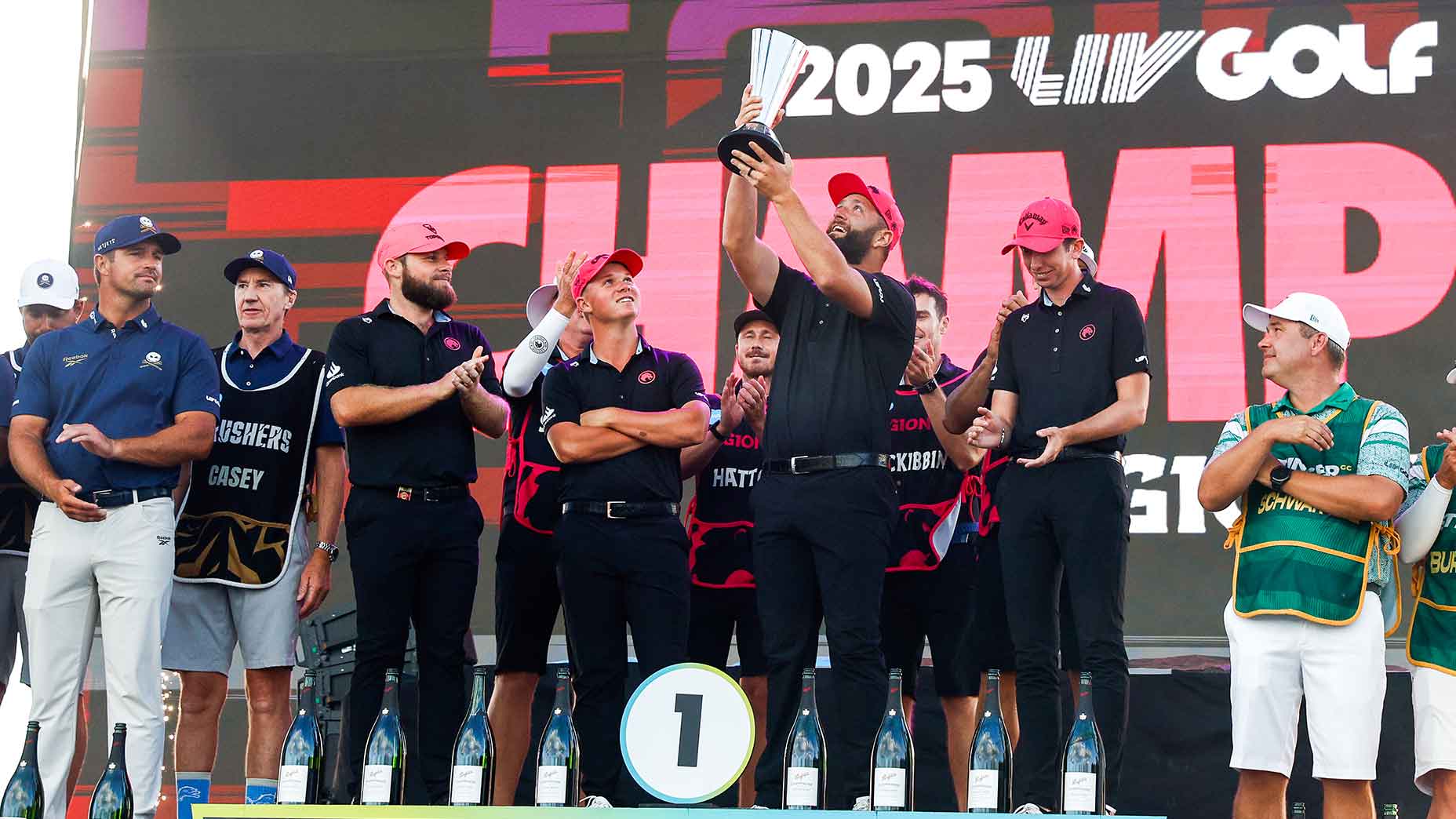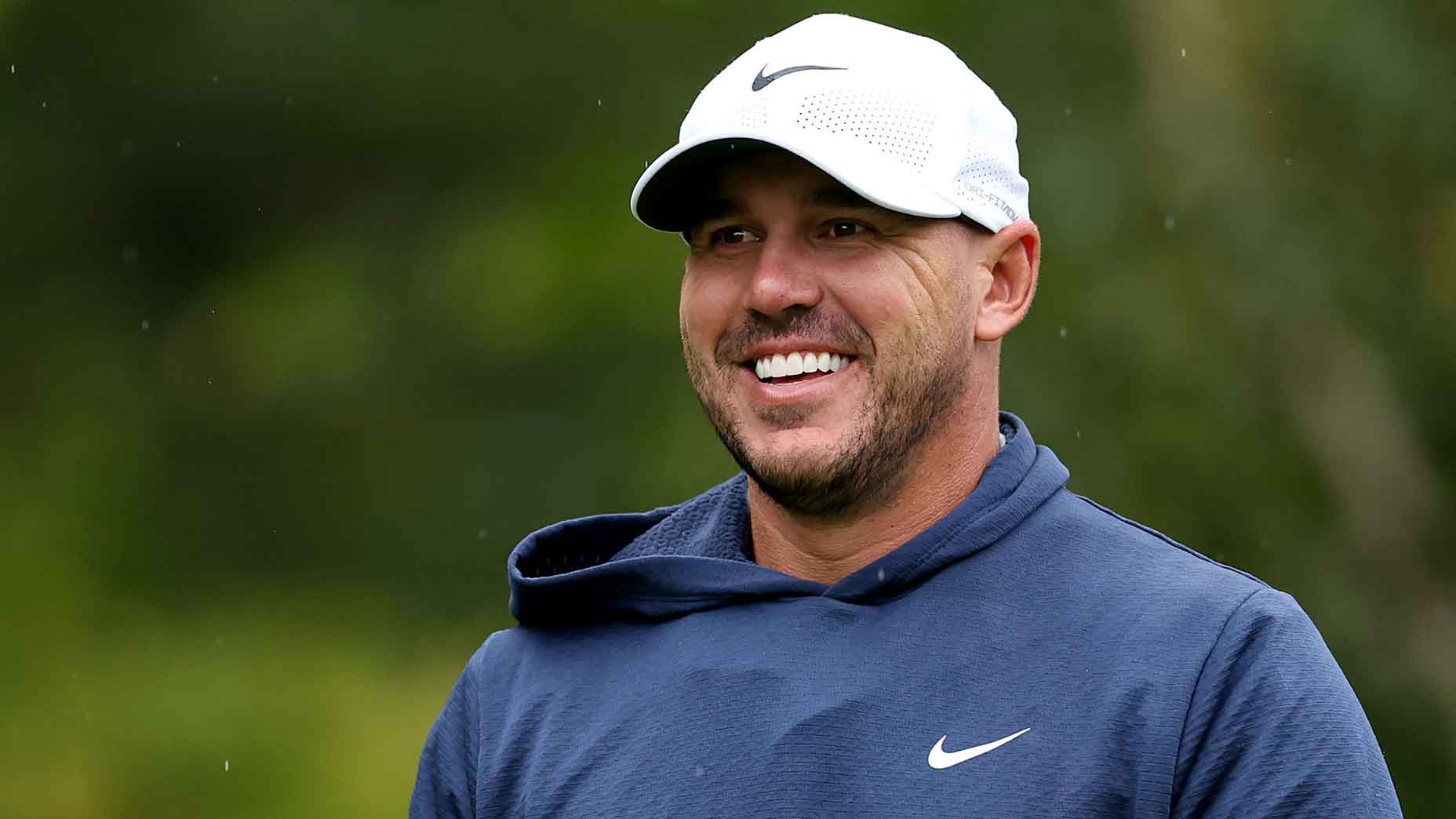Life, like Greg Norman’s argument for instant world ranking points, is all a matter of perspective.
From one perspective, LIV Golf is staging tournaments with some of the most talented golfers in the world. They have major champions, former World No. 1s and some of the most recognizable names and biggest personalities in the sport. The fact that these pros regularly compete against each other and even the winners are plummeting in the world rankings reveals an obvious blind spot in the system. Continuing to deny them points would be ridiculous!
From another perspective, LIV is staging a brand-new tournament series of limited, closed-field events that satisfy only a portion of the OWGR criteria. Now they’re demanding instant recognition and special exemption from an in-depth, intensive review process — and now they’re thumbing their nose at that process through the bizarre takeover of a dormant mini-tour. Giving in to their demands would be ridiculous!
You can see why things have gotten heated.
So let’s boil it down to the essentials. What is the Official World Golf Ranking (OWGR), how can a new tour gain its recognition and what are the barriers for LIV to get there? Here are 10 questions — and answers! — about the mysterious process.
1. Why do people care about the OWGR?
For decades, a male golfer’s professional standing has been represented by his world ranking. It’s his resume, his VIP badge, his passport. It’s the way he gets compared to players who aren’t on his tour. More specifically, his world ranking dictates whether or not he can play in some of the biggest events on the calendar, including the major championships.
That’s a significant reason LIV golfers care about the OWGR: They still want to play the majors. While LIV has demonstrated some interest from an emerging fan base, golf careers and legacies are still defined by performance in majors. Some LIV pros are recent major winners and have exemptions into the biggest championships (think Bryson DeChambeau and Dustin Johnson, who won the U.S. Open and Masters in 2020, Phil Mickelson, who won the 2021 PGA and Cameron Smith, who won this year’s Open) but others are clinging to their ranking as means of qualification (think Joaquin Niemann or Talor Gooch).
As a result, the OWGR’s ruling — and timing — is a big deal. If LIV is awarded points, its members can more easily leave the PGA Tour in their rearview mirror, knowing they’ll still be able to qualify for the majors through strong play on LIV. Until then, they’re in limbo. That limbo has already contributed to lawsuits, to resentment, to dramatics. There’s likely to be more of all of the above.
2. What’s the rush?
LIV CEO Greg Norman has made it clear he wants points and he wants them now. LIV pros underscored that point in a September letter to the OWGR board (more on that shortly) and doubled down with a surprising end-around to the little-known MENA Tour this past week (more on that shortly, too).
But there’s a reason this is an urgent matter for LIV pros. Because they’re suspended from the PGA Tour, they aren’t earning points there or on LIV. They still have some opportunities to earn points — some are still qualified for majors, while others have played on the DP World Tour and Patrick Reed has been barnstorming various world stages — but their rankings are plummeting nonetheless. This is doubly bad news for LIV because nearly every member of their field will have a lower ranking. So if LIV is awarded points in a year, say, those points will be worth mere pennies on the dollar because the field strength will be so greatly reduced. LIV members knew this risk when they made the jump to LIV, but now they’re speaking out in the hopes of an expedited process.
“When they keep holding it back, they’re going to just keep playing a waiting game where we’re going to keep dropping down in the rankings to where our points won’t ever matter,” DeChambeau said in Thailand this week. “That’s what they’re trying to accomplish, and I hope that people can see right through that rather than believe the lies that they’ve been told. From my perspective, I think we deserve points.”
3. Who made this thing, anyway?
Here’s the short history of the OWGR: In the 1960s, pioneering sports agent Mark McCormack made his own ranking. He did this on his own until 1986, when the OWGR was officially recognized so that players splitting time between the European and PGA Tours could be more accurately measured, even if they weren’t atop either money list. McCormack’s agency, IMG, owned the OWGR until 2004, when a company called OWGR Limited took over operation.
4. Who runs the OWGR?
There OWGR is governed by a seven-person board of directors. That governing board is chaired by Peter Dawson, the former Chief Executive of the R&A, and is comprised of representatives from the PGA Tour, the DP World Tour, the International Federation of PGA Tours and then one rep from each of the bodies that run the four majors. Here’s what that looks like:
GOVERNING BOARD
Chairman: Peter Dawson
Representing Augusta National Golf Club: Will Jones, Executive Director
Representing the DP World Tour: Keith Pelley, Chief Executive
Representing the PGA of America: Seth Waugh, Chief Executive Officer
Representing the PGA Tour: Jay Monahan, Commissioner
Representing the R&A: Martin Slumbers, Chief Executive
Representing the USGA: Mike Whan, Chief Executive Officer
Representing the International Federation of PGA Tours: Keith Waters
There’s also a 10-person Technical Committee, which we’ll get to in a second, but if you’re LIV and you’re looking at the above list, you might not be particularly enthused. That board is a who’s-who of establishment figures in professional golf, at least a couple of whom have publicly stated their objections to LIV’s approach.
There has been no indication that the OWGR board has allowed personal feelings about LIV to affect the process. But if LIV is looking for the OWGR to expedite the process and do its members a favor, this might not be the most sympathetic group.
5. What are OWGR criteria?
Good question! The specific criteria for a startup golf league trying to join the OWGR aren’t really public (they declined a GOLF.com request for comment), and the extent to which tours have to follow the letter of the law is slightly unclear. On top of that, the aforementioned governing board can interpret the criteria as it wishes, change the rules as it sees fit and decide whatever it wants. Still, there are some general requirements, which include:
-A “sponsor” tour, one of the six “Full Member” tours, to propose the new tour’s inclusion. In this case, the Asian Tour nominated LIV, essentially vouching for its legitimacy.
-An opportunity for players from the new tour to gain access to the sponsoring tour. In this case, that means LIV players must have an avenue to playing the Asian Tour. (They will have that opportunity.)
-A chance for golfers to qualify for the tour, whether through qualifying schools, weekly qualifiers or both. The PGA Tour, for example, has a Q-school that feeds to the Korn Ferry Tour, which feeds to the PGA Tour. The majority of its events also have Monday qualifiers the week of the event. LIV’s hand-picked teams and fields are at odds with this qualifying process but they have introduced plans that involve relegation and promotion that could satisfy this requirement.
-An average of at least 75 players per tournament field. That’s an issue for LIV, whose shotgun start features 48 pros. But they believe they’ve built in a workaround thanks to the Asian Tour’s International Series, which features 144-player fields and would pull up LIV’s average.
-Scheduled 72-hole tournaments with 36-hole cuts. Exceptions have been made for the 72-hole component for developmental tours, including the MENA Tour, which regularly played 54-hole events. More on that in a moment, but LIV’s 54 holes may or may not be an issue here — and its lack of a cut could give the board pause, too. LIV has pointed out that the PGA Tour has no-cut, limited-field events, like the Tour Championship or the Sentry Tournament of Champions. That’s true, although the difference is that players have qualified for those events through their play on Tour.
-Following the Rules of Golf and following non-discriminatory practices towards players.
One other important bit: A tour is supposed to operate for a year under these requirements before gaining approval. LIV says there have been exceptions to that rule, too — but that’s another point of tension as its players rankings continue to fall.
6. How long does the process take?
The short answer? Roughly 12-18 months. Typically applications are reviewed by the governing board and by OWGR’s Technical Committee, a 10-person committee consisting of representatives from some of golf’s most significant governing bodies. The committee then instructs the applicant on the status of its proposal and what changes it might make to better satisfy OWGR requirements.
The OWGR announced it had received LIV’s application on July 13th, the Tuesday of the Open Championship.
“Examination of the application will now commence,” Peter Dawson wrote in a release. The OWGR board met that week to begin discussions around LIV’s inclusion.
7. What on earth is this MENA Tour story?
Great question. Earlier this week, LIV announced that it had formed a strategic alliance with the MENA (Middle Eastern and North African) Tour, a developmental feeder to the Asian Tour. LIV events are now MENA events, and LIV pros are now MENA Tour pros. Because MENA has been OWGR-sanctioned since 2016, Norman and LIV execs trumpeted the move as giving them an immediate right to OWGR points.
It was hard to immediately tell whether the move was borne of aggression, desperation, strategy, trolling or some combination of the above. It wasn’t a sudden impulsive move — LIV’s plans with MENA had been in the works — but it certainly signaled a lack of confidence in the official process.
LIV did force a response from the OWGR, which declined to award points to this week’s event in Bangkok or LIV’s next event in Saudi Arabia, pending further review.
“Notice of these changes given by the MENA Tour is insufficient to allow OWGR to conduct the customary necessary review ahead of the LIV Golf Invitational Bangkok (7-9 October) and LIV Golf Invitational Jeddah (14-16 October),” a statement posted to the OWGR website and social media handles said. “Only after the review is complete will a decision be made on awarding points to the MENA Tour’s new ‘Limited Field Tournaments,’ defined by the MENA Tour in its Regulations as ‘any MENA Tour-approved tournament, which comprises of a player field of less than 80 players.’”
It’s not immediately clear whether the move could accelerate LIV’s path to OWGR-dom, or whether it could actually backfire; that LIV is chasing legitimacy but partnering with a mini-tour and alternating event purses of $20 million (for LIV events) with $75,000 (for regular MENA events) is, on its face, ridiculous. Perhaps that’s part of the point; if LIV can’t join the system, it will hope to undermine its very structure.
8. What is Greg Norman saying?
Norman sounded off on Friday in a TV interview with WION (video below) following this week’s push-back from the OWGR.
“No, it’s not a setback,” he said. “It’s a setback for them. Because quite honestly my players should have it. There’s 22 tours out there, I believe, that have world ranking points. There’s only one that’s either equal or a little bit superior to what LIV is. Only one out of those 22. So it doesn’t make sense from a major’s perspective, it doesn’t make sense from a broadcaster’s perspective. You’re paying and investing for your strength of field. And by degrading the strength of field by not allowing LIV players to get OWGR points, it’s not doing the game of golf any good.
“Rise above it all. It’s good for the players, it’s good for the game of golf, it’s good for production, it’s good for corporations, it’s good for OEMs, it’s good for fans, it’s good for everybody — just because you have a negative viewpoint, and you’re one of the voting members of an independent organization, that you hate LIV, that you’re going to vote against it? Grow up.”
🚨#NEW: Greg Norman sounds off on the OWGR pic.twitter.com/p1YBY46e4x
— NUCLR GOLF (@NUCLRGOLF) October 7, 2022
The head of the MENA Tour added his own objections in a release.
9. What are LIV players saying?
This won’t come as a huge shock, but LIV golfers are suggesting that they should, in fact, get points! Many of the circuit’s big names have spoken out in favor, most recently the unlikely alliance of Bryson DeChambeau and Brooks Koepka, who took to the mic after Friday’s round.
“They’re delaying the inevitable,” DeChambeau said. “We’ve hit every mark in their criteria, so for us not to get points is kind of crazy with having – at least I believe – we have the top players in the world. Not all of them, but we certainly believe that there’s enough that are the top 50 and we deserve to be getting world-ranking points.”
“I don’t think it really was much of a response,” Koepka added. “I just hate when you sit on the fence. Just pick a side. If it’s a yes or no, just pick one. So I’m not a big fan of that. … If it’s a yes, if it’s a no, it’s fine. We’ll figure it out from there.”
10. What are non-LIV players saying?
In general, PGA Tour and DP World Tour pros agree that LIV golfers should get world ranking points — but they also recognize the process is in place for a reason.
“I hope for them that it does go through and they get World Ranking points. It seems like if 48 great golfers play in a tournament, week in and week out, to my eye, should get points,” Max Homa said at the Presidents Cup. “But there is a criteria. That’s how the world works.”
Matthew Fitzpatrick urged patience, too.
“I understand why they think they deserve points because of the players they’ve got, and don’t disagree with that, but if you look at all the other tours in previous years that have gone through the official process then it takes a year or two,” he told Sky Sports.
“If they meet the criteria they get world ranking points,” McIlroy told Sky Sports News ahead of the Dunhill Links. “I don’t see any reason why they shouldn’t, as long as they meet the criteria that is set out.
“The one thing that has been frustrating from the start of this is that they don’t want to play by the rules that have been in place for so long. It can’t be one set of rules for a certain amount of people and then a certain set of rules for everyone else — everyone has to abide by the same rules here.”
Time will tell whether LIV’s hammer of disruption is powerful enough to bludgeon through the OWGR’s process. These are unprecedented times, after all, and golf’s institutions have proven they’re hardly immune to outside forces. Every LIV story seems to end this way, with our 11th question: What’s next? We don’t have that answer just yet.
The author (cautiously) welcomes your comments at dylan_dethier@golf.com.










